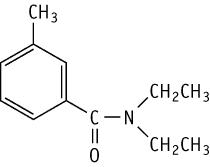For more information from the CDC please click the following link: click here

Information
Center For Disease Control Advice
About Deet
A mosquito uses a combination of carbon dioxide, odor and infrared sensors to find their victims. DEET affects these sensors and, as a result, the mosquito is not able to trace a user’s health and therefore looks for another victim. DEET doesn’t kill mosquitoes but protects people by keeping mosquitoes at a distance.
N,N-diethyl-meta-toluamide as an active ingredient for insect repellents was discovered by the US army in 1946. Since 1957 it has been used by the public, implying a track record of over 50 years of public use. Throughout these 50 years a broad variety of test protocols have come and gone. Of course different opinions are related to different tests and scientists. Today deet is still one of the most commonly used actives for insect repellents and repels a broad range of insects and arachnids: mosquitoes, ticks, biting flies, midges, chiggers and fleas.
For more information on DEET, please click the following link: click here.

Directions for Use
DIRECTIONS FOR USE
It is a violation of federal law to use this product in a manner inconsistent with its labeling. Read and follow all directions and precautions on the product label. Use just enough repellent to cover exposed skin and/or clothing. Avoid over-application of this product. Do not use under clothing. Do not allow children to handle this product. Do not apply to children’s hands. When using on children, apply to your own hands, then put it on the child. After returning indoors, wash treated skin with soap and water. May damage certain synthetics, furniture, plastics, leather, watch crystals, and painted or varnished surfaces.
Physical/Chemical Hazards
Keep away from heat and open flame.
Storage and Disposal
Do not contaminate water, food, or feed by storage and disposal. Pesticide Storage: Store in a cool, dry area away from heat, open flame and children. Container Disposal: If empty: Non-refillable container. Do not reuse or refill this container. Offer for recycling, if available. If partly filled: Call your local solid waste agency for disposal instructions.
Precautionary Statements
HAZARDS TO HUMANS
WARNING: Causes substantial but temporary eye injury. Do not get in eyes. Do not apply near eyes and mouth. Do not apply over cuts, wounds, or irritated skin. Apply sparingly around ears. Wash hands thoroughly with soap and water after handling and before eating, drinking, chewing gum, or using tobacco. Wash treated clothing before wearing it again. Use of this product may cause skin reactions in rare cases. If you suspect a reaction to this product, discontinue use, wash treated skin, and call your local poison control center. If you go to a doctor, take this product with you.
FIRST AID
IF IN EYES: Hold eye open and rinse slowly and gently with water for 15 – 20 minutes. Remove contact lenses, if present, after the first 5 minutes, then continue rinsing eye. Have the product or label with you when calling a poison control center or doctor, or going for treatment.
Material safety data sheet (MSDS)
To reference the Material Safety Data Sheet, please click the following link: click Here
